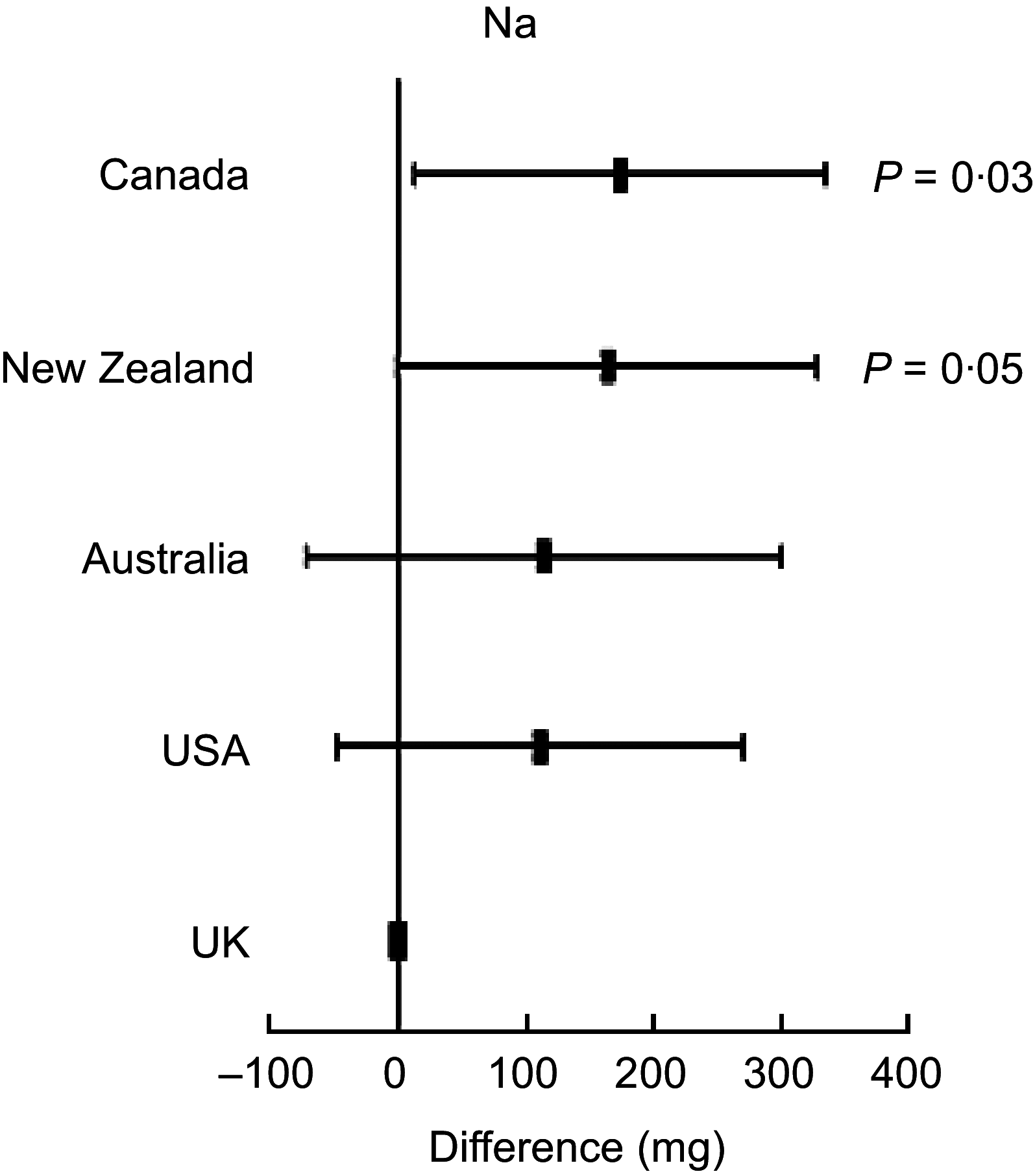Nutritional quality of food items on fast-food 'kids' menus': comparisons across countries and companies
- PMID: 24148879
- PMCID: PMC10282608
- DOI: 10.1017/S1368980013002498
Nutritional quality of food items on fast-food 'kids' menus': comparisons across countries and companies
Abstract
Objective: To compare energy (calories), total and saturated fats, and Na levels for 'kids' menu' food items offered by four leading multinational fast-food chains across five countries.
Design: A content analysis was used to create a profile of the nutritional content of food items on kids' menus available for lunch and dinner in four leading fast-food chains in Australia, Canada, New Zealand, the UK and the USA.
Setting: Food items from kids' menus were included from four fast-food companies: Burger King, Kentucky Fried Chicken (KFC), McDonald's and Subway. These fast-food chains were selected because they are among the top ten largest multinational fast-food chains for sales in 2010, operate in high-income English-speaking countries, and have a specific section of their restaurant menus labelled 'kids' menus'.
Results: The results by country indicate that kids' menu foods contain less energy (fewer calories) in restaurants in the USA and lower Na in restaurants in the UK. The results across companies suggest that kids' menu foods offered at Subway restaurants are lower in total fat than food items offered at Burger King and KFC, and food items offered at KFC are lower in saturated fat than items offered at Burger King.
Conclusions: Although the reasons for the variation in the nutritional quality of foods on kids' menus are not clear, it is likely that fast-food companies could substantially improve the nutritional quality of their kids' menu food products, translating to large gains for population health.
Figures


Similar articles
-
The Nutritional Quality of Kids' Menus from Cafés and Restaurants: An Australian Cross-Sectional Study.Nutrients. 2022 Jun 30;14(13):2741. doi: 10.3390/nu14132741. Nutrients. 2022. PMID: 35807919 Free PMC article.
-
Nutritional quality of meals offered to children (kids' meals) at chain restaurants in Japan.Public Health Nutr. 2018 Dec;21(17):3101-3110. doi: 10.1017/S1368980018001891. Epub 2018 Aug 15. Public Health Nutr. 2018. PMID: 30109837 Free PMC article.
-
Changes in the nutritional quality of fast-food items marketed at restaurants, 2010 v. 2013.Public Health Nutr. 2018 Aug;21(11):2117-2127. doi: 10.1017/S1368980018000629. Epub 2018 Mar 27. Public Health Nutr. 2018. PMID: 29580301 Free PMC article.
-
Modeling potential effects of reduced calories in kids' meals with toy giveaways.Child Obes. 2014 Feb;10(1):58-63. doi: 10.1089/chi.2013.0082. Epub 2013 Dec 4. Child Obes. 2014. Retraction in: Child Obes. 2014 Dec;10(6):546. doi: 10.1089/chi.2014.1062. PMID: 24304430 Retracted. Review.
-
State and Local Healthy Kids' Meal Laws in the United States: A Review and Content Analysis.J Acad Nutr Diet. 2022 Oct;122(10):1864-1875.e19. doi: 10.1016/j.jand.2021.12.003. Epub 2021 Dec 8. J Acad Nutr Diet. 2022. PMID: 34896300 Free PMC article. Review.
Cited by
-
Nutrient composition of Australian fast-food and fast-casual children's meals available in 2016 and changes in fast-food meals between 2010 and 2016.Public Health Nutr. 2019 Nov;22(16):2981-2988. doi: 10.1017/S1368980019001897. Epub 2019 Sep 12. Public Health Nutr. 2019. PMID: 31514763 Free PMC article.
-
The Nutritional Quality of Kids' Menus from Cafés and Restaurants: An Australian Cross-Sectional Study.Nutrients. 2022 Jun 30;14(13):2741. doi: 10.3390/nu14132741. Nutrients. 2022. PMID: 35807919 Free PMC article.
-
Tackling (Childhood) Obesity through a Voluntary Food Reformulation Policy: A Repeated Cross-Sectional Study Investigating Nutritional Changes in the Out-of-Home Sector.Nutrients. 2023 Jul 14;15(14):3149. doi: 10.3390/nu15143149. Nutrients. 2023. PMID: 37513567 Free PMC article.
-
Why a global convention to protect and promote healthy diets is timely.Public Health Nutr. 2014 Nov;17(11):2387-8. doi: 10.1017/S1368980014002031. Public Health Nutr. 2014. PMID: 25248457 Free PMC article. No abstract available.
-
Differences in energy and nutritional content of menu items served by popular UK chain restaurants with versus without voluntary menu labelling: A cross-sectional study.PLoS One. 2019 Oct 16;14(10):e0222773. doi: 10.1371/journal.pone.0222773. eCollection 2019. PLoS One. 2019. PMID: 31618202 Free PMC article.
References
-
- Appel L, Brands M, Daniels S et al. et al. (2006) Dietary approaches to prevent and treat hypertension: a scientific statement from the American Heart Association. Hypertension 47, 296–308. - PubMed
-
- Langlois K, Garriguet D & Findlay L (2009) Diet composition and obesity among Canadian adults. Health Rep 20, issue 4, 11–20. - PubMed
-
- World Health Organization (2009) Global Health Risks: Mortality and Burden of Disease Attributable to Selected Major Risks. Geneva: WHO; available at http://www.who.int/healthinfo/global_burden_disease/GlobalHealthRisks_re...
Publication types
MeSH terms
Substances
Grants and funding
LinkOut - more resources
Full Text Sources
Other Literature Sources
Medical

